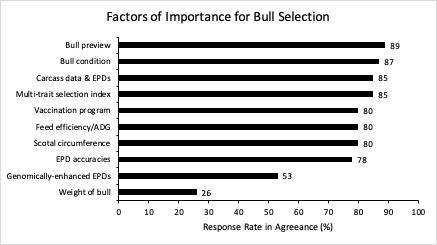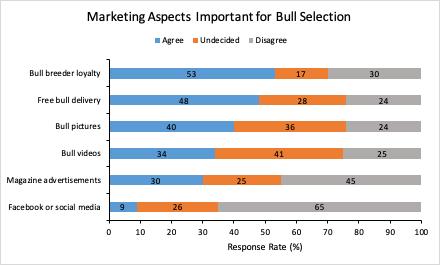
6 minute read
Bull survey results updated
RESULTS ARE IN CALIFORNIA RANCHER’S SELECTION AND MANAGEMENT OF HERD BULLS SURVEY UPDATE
by Zach McFarlane, Ph.D., California Polytechnic State University, San Luis Obispo; Tracy Schohr, M.S., University of California Cooperative Extension; and Kasey DeAtley, Ph.D., California State University, Chico
Raising cattle in California comes with a multitude of challenges when considering the environment alone. Producers need cattle that can adapt to the state’s diverse regional climates, topography and rangeland conditions. Specifically, bulls need to be able to successfully breed cows and remain sound in extensive rangeland conditions. Few research studies have investigated factors related to the selection, purchase, management and longevity of bulls on California’s rangelands.
Therefore, the objectives of this research study with Cal Poly, San Luis Obispo, California State University, Chico and University of California Cooperative Extension were to assess the factors related to bull purchasing decisions, management and culling decisions of California beef producers. A total of 1,410 surveys were mailed to the California Cattlemen’s Association membership. Approximately 220 individuals have mailed in their responses or completed the online version, resulting in a 16 percent response rate to date. Surveys are still being collected and we encourage the membership to respond in the online version (ucanr.edu/bullsurvey) or complete the mailed catalog.
Preliminary results of this study are discussed below, with a select highlight of the 35 total questions from the survey. Keep in mind that the results may change as more data are collected from producers. Please check your mail for a postcard that provides a QR code and the link for the online version of the survey.
Demographic Findings
The average California beef producer is approximately 61 years old with 27 years of experience. Respondents manage cattle on more than 1.7 million acres of owned, privateleased and public leased rangelands in California and surrounding states. Most respondents were cow-calf producers that managed a herd size of 378 head on average; however, herd sizes were highly variable across the state. California producers had a bull battery that averaged 18 head of bulls with an average longevity of five years.
The survey results showed 60 percent of respondents purchase a 74 California Cattleman September2020 bull every year. The preferred purchase method was at a bull sale (44 percent), by private-treaty (26 percent) or a combination of sales and private treaty purchases (25 percent). Producers attended an average of two sales per year, while 80 percent of survey respondents do not attend any online sales during the year.
Respondents preferred to purchase long-yearlings (56 percent of respondents; bulls aged about 18 months). The predominate breed of bull purchased was Angus (66 percent). Bull buyers paid an average price of just over $5,000 in the last two years, while the average highest price reported by producers to have paid in the last five years was just below $7,000. In all, 71 percent of survey respondents indicated that limited bull guarantees were important for their bull purchasing decision.
Selection Criteria
Expected progeny differences (EPDs) have been used as selection criteria in order to promote genotypic selection in the most utilized breeds of beef cattle. Breed associations and research scientists are constantly working on increasing the accuracy of these genetic prediction tools for producers. In this study, we wanted to
...CONTINUED ON PAGE 76
...CONTINUED FROM PAGE 74 operation is continuously improving our genetics and we understand the EPDs that California producers utilize Modoc County. This research project provides a baseline for bull selection. The following EPDs were listed as for our industry that is continuously evolving, and this priorities for bull selection and respondents were asked information gives guidance for future research.” to rank from the highest to lowest priority: birth weight, Researchers recognize bull producers consider EPDs, calving ease direct, weaning weight, yearling weight, along with a cross section of other factors when selecting scrotal circumference and milk. Producers indicated a bull. We asked producers a series of questions about calving ease (73 percent birth weight and calving ease elements that play a role in their purchasing decision. direct combined) and weaning weight (21 percent) EPD The following options were provided: strongly agree, as their highest priority when selecting bulls. The American Angus Association has developed a wide-array of dollar-value indices that are linked to economically-relevant traits. Index values combine agree, undecided, disagree and strongly disagree. The data has been summarized for respondents that agreed and strongly agreed in Figure 1, while the response categories multiple data sources into one EPD value to allow were summarized into Agree, Undecided, or Disagree in for ease of selection in order to facilitate substantial Figure 2. directional changes in production efficiency. We again asked producers to rank the highest priority for price indices with the following EPDs: FIGURE 1. Survey responses to selection factors related to bull phenotype and genotype that are important for bull selection. Beef Value ($B), Maternal Weaned Calf Value ($M), Weaned Calf Value ($W), Cow Energy Value ($EN), Quality Grade ($QG), Yield Grade ($YG) and Grid Value ($G).
Respondents recognized Beef Value (38 percent), Weaned Calf Value (27 percent), Maternal Weaned Calf Value (17 percent) and Cow Energy Value (10 percent) as their highest priorities. These results align with the EPD results and demonstrate the focus of California producers on calving ease and weaned calf performance for their bull selection criteria. FIGURE 2. Survey responses to questions related to marketing attributes
Producers were asked to rank criteria that are considered relevant and important for bull selection. that were considered the most important for their bull purchasing decision. The primary criteria that producers considered for bull selection was structural soundness and confirmation (59 percent) and expected progeny differences (23 percent). “As a seedstock producer, I am interested to learn from the study of cattlemen on what is important to them. EPDs are essential, but we know there is a cross section of other factors cattlemen consider when selecting a bull,” said Steve Lambert, Lambert Hereford Ranch, Oroville. “Our family have expanded our reach with a sale in both Butte and


Bull Management
We asked California cattlemen a series of five questions to define current bull management practices post-purchase and for the following breeding seasons until a bull is culled. After bull purchase, 46 percent of producers turned bulls out directly with females, while 49 percent held bulls until the following breeding season. Most producers (75 percent of respondents) do not manage bulls to reduce condition after purchase. Researchers also asked producers how bulls were typically managed on their operations; 47 percent of respondents use a bull pasture to manage bulls in the off-season, while 23 percent of respondents used a combination of a bull pasture and supplemental forages in a pen (e.g. hay).
When asked about annual veterinary care, semen quality was evaluated annually by 45 percent of producers, while 20 percent of producers reported they never evaluated semen quality. The most common factors associated with culling bulls were bull age (35 percent) and structural soundness (29 percent). Bull longevity was moderately correlated with the average purchase price a producer paid in the last two years.
Conclusion
Bulls represent the primary source of new genetics in the herd. The initial results presented in this study are a first glance at this complex and critical component of cow-calf operations. Researchers look forward to getting back more surveys from California ranchers throughout the fall and linking the findings to provide better continuing education to producers and feedback to seedstock producers. Additionally, this research indicates the need for additional research focused on bull selection and management to maximize producer investment in genetics and reproduction.
We will continue to collect and analyze data from survey respondents, and we plan to provide the final update at the California Cattlemen’s Association annual convention during the Rustici/ California Beef Cattle Improvement Association (CBCIA) Poster Session and the CBCIA meeting.
This research project was made possible by funding and support from the California Beef Cattle Improvement Association, California Cattlemen’s Association, Cal Poly San Luis Obispo and Poor Richard’s Press. We would like to acknowledge the efforts of Cal Poly students Katie Peterson, Claire Stevenson, and Jack Cameron for their help with data collection and analysis.










